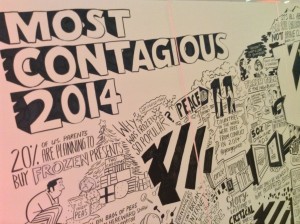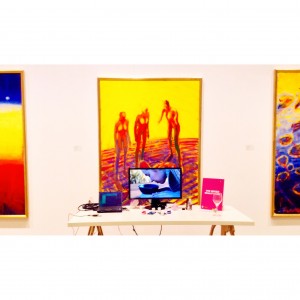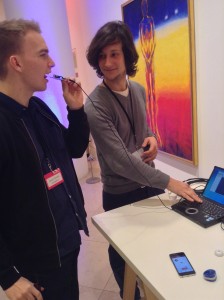
By MARK DUELL FOR MAILONLINE
PUBLISHED: 05:58, 19 December 2014 | UPDATED: 15:47, 19 December 2014
- Scientists sent smell of champagne from Paris to US with iPhone in June
- oPhone Duo device can recreate smell out of palette of 32 available scents
- And the Scentee iPhone attachment can release aroma upon receiving text
- Emerging technologies forecast by innovation charity Nesta to make it big
- Others include life-saving apps and food waste feeding millions of people
Smartphones will be sending and receiving scented messages by the end of next year, experts say.
The concept is one of ten emerging technologies forecast by innovation charity Nesta to make it big 2015, with others including life-saving apps and food waste feeding millions of people.
It comes six months after scientists managed to send the smell of champagne and macarons from Paris to New York with an iPhone app using a device called the oPhone Duo.

The system consists of an oSnap app which allows users to create an oNote with a smell created out of a palette of 32 available scents that can be combined in 300,000 possible combinations.
The oNote can then be sent to the oPhone hardware – a device which is able to recreate the smell.
Other technology in this field is the Scentee device, which can release a favourite aroma at the same time as a phone clock alarm or when an individual receives a text message.
It also claims to be able to change the taste of food with its mini air-freshener-like alcohol-based aroma cartridges. A user can select to emit a puff of scent at will using the small plastic device.
City University computing professor Adrian Cheok developed the technology behind Scentee and is now working on a device that will send a magnetic signal to a mouthguard in the back of the throat.

Nesta project manager Josh McNorton said: ‘Imagine the next selfie you see posted is accompanied by the scent of perfume. The Instagram photo of your gourmet steak dinner comes with a whiff of buttery mashed potatoes.
‘The olfactory overload of a Sunday afternoon visit to your local flower market can be texted to a friend a thousand miles away. In 2015, I predict that the ability to digitally transmit smells will hit the mainstream.’
It has been more than half a century since the concept of ‘Smell-O-Vision’ was introduced to cinema audiences, making its first widespread appearance in the 1960 film Scent Of Mystery.
The film opened in three specially-equipped theatres in New York, Chicago and Los Angeles – with the idea being that certain odours would be timed to specific points in the narrative.
But the mechanism did not work properly and audience members complained of a hissing noise accompanying the scents – as well as a delay between the actions and their corresponding smells.
Mr McNorton added: ‘While we’ve turned our noses up at past attempts, I believe 2015 is the year “smell-o-vision” will finally lose its stink.’
Another prediction is of a huge innovation in first aid that will see ambulance trusts incorporate smartphone technology locating local trained first aiders, who can respond instead of paramedics.
It is also claimed that in 2015 enough fruit and vegetables will be diverted from food waste to feed millions of people, through ‘gleaning’ harvest food that would be otherwise left to rot in farms.
Of Nesta’s ten 2014 predictions, one of the most interesting is that there would be an ‘introduction of services that help us improve our lives based on the data that we give away every day’.
SMELLS ON SCREENS: A HISTORY
Smell-O-Vision was a system created in 1960 by Hans Laube, and was used in cinemas during the film Scent of Mystery.
The system was fitted to cinema seats and released 30 smells at different points during the film, triggered by the film’s soundtrack. Smells included pipe tobacco.
In 2013, researchers in Tokyo developed a prototype smelling screen. The smelling screen combines a digital display with four small fans, one at each corner of the display.
Smells are stored in gel packets and are released at set times. The smells are blown parallel to the screen. By varying the speed and strength of each fan, the different smells are moved to specific areas of the screen.
2015’S TRENDS, SOCIAL MOVEMENTS AND TECH BREAKTHROUGHS (via Nesta)
- Democracy makes itself at home online: 2015 will see the creation of new political parties organised in radically different ways
- Smell-O-Vision loses its stink: This year you’ll receive an SMS with a difference as technology is introduced to transmit scents through your smartphone
- Internet of everything, coming to a neighbourhood near you: 2015 will bring new network technologies that connect constellations of low-powered sensors across entire districts, creating widespread smart civic infrastructure
- Digital art gets up close and personal: This year digital art will become entrenched in daily life as cultural producers exploit digital technologies to create more accessible experiences
- Killer apps for life savers: This year smartphone tech will fuel the biggest innovation in first aid for over 100 years
- Crafts get a 21st century makeover: Shared access to digital fabrication tools such as laser cutters and 3D printers will create a new breed of digital artisan manufacturers
- Gleaning will change our attitude to food waste: In 2015, enough fruit and veg will be diverted from food waste to offer millions one of their five a day
- A bust funded by the crowd: 2015 will see a high-profile blow-up in the world of crowdfunding and peer-to-peer lending. But this is a good sign, not a bad one
- Programming a new generation of digital makers: From apps to films, in 2015 every young person across the UK will make and share something digital
- Crowd-aware billboards: This year cities will play host to Minority Report style billboards broadcasting tailored content based on data from your GPS-enabled phone
Read more: http://www.dailymail.co.uk/sciencetech/article-2880142/Smell-O-Vision-21st-Century-Phones-able-send-scented-messages-ten-emerging-technologies-2015.html#ixzz3NQ6YZylo






 Imagine the next selfie you see posted is accompanied by the scent of perfume. The Instagram photo of your gourmet steak dinner comes with a whiff of buttery mashed potatoes. The olfactory overload of a Sunday afternoon visit to your local flower market can be texted to a friend a thousand miles away. In 2015, I predict that the ability to digitally transmit smells will hit the mainstream.
Imagine the next selfie you see posted is accompanied by the scent of perfume. The Instagram photo of your gourmet steak dinner comes with a whiff of buttery mashed potatoes. The olfactory overload of a Sunday afternoon visit to your local flower market can be texted to a friend a thousand miles away. In 2015, I predict that the ability to digitally transmit smells will hit the mainstream.

